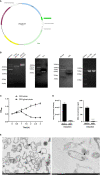Comparative study of subcutaneous, intramuscular, and oral administration of bovine pathogenic Escherichia coli bacterial ghost vaccine in mice
- PMID: 36451816
- PMCID: PMC9702981
- DOI: 10.3389/fimmu.2022.1008131
Comparative study of subcutaneous, intramuscular, and oral administration of bovine pathogenic Escherichia coli bacterial ghost vaccine in mice
Abstract
Escherichia coli is one of the most common bacterial pathogens in cattle. Prophylactic vaccines are considered promising strategies with the potential to reduce the incidence of colibacillosis. Some studies suggested that bacterial ghosts may serve as a novel approach for preventing bacterial infections. However, the roles of administration route on vaccine immunogenicity and efficacy have not been investigated. In this study, the efficacy of vaccination via different immune routes in generating humoral and cellular immune response was compared through subcutaneous (SC), intramuscular (IM), and oral (O) administration in female BALB/c mice with bacterial ghosts prepared using wild type Escherichia coli isolates CE9, while phosphate buffer saline (PBS) and inactivated vaccines containing aluminum adjuvants (Killed) were used as control. Our results showed that the plasmid pBV220-E-aa-SNA containing E. coli was efficiently cleaved at 42°C with 94.8% positive ratio as assessed by colony counts. Transmission electron microscopy (TEM) confirmed bacteria retained intact surface structure while devoid of cytoplasmic component. We found that total IgG titers in killed, IM and SC groups showed significant increase on 7, 14, 21 and 28 days post-immunization. The IgA level of the IM group was higher than that of all other groups on the 28th day. Meanwhile, four experimental groups showed a significant difference in IgA levels compared with PBS control. In the IM group, an increase in the relative percentages of CD3+CD4+ T cells was accompanied by an increase in the relative percentages of splenic CD3+CD8+ T cells. In comparison with the inactivated vaccine, intramuscular CE9 ghosts immunization elicited higher levels of IL-1β, IL-2, IL-6 and IL-12. Subcutaneous and intramuscular immunizations were significantly associated with improved survival in comparison with oral route, traditional vaccine and the control. Pathologic assessment revealed that less severe tissue damage and inflammation were found in lung, kidney, and intestine of IM group compared with other groups. The results above demonstrate that immunization of Escherichia coli CE9 ghosts via intramuscular injection elicits a more robust antigen-specific immune response in mice to prevent the Escherichia coli infection.
Keywords: Escherichia coli; bacterial ghosts; humoral immunity; lysis cassette; pBV220 vector.
Copyright © 2022 Mu, Lei, Zheng, Li, Li, Fu, Wang and Liu.
Conflict of interest statement
The authors declare that the research was conducted in the absence of any commercial or financial relationships that could be construed as a potential conflict of interest.
Figures






Similar articles
-
Preparation of porcine enterotoxigenic Escherichia coli (ETEC) ghosts and immunogenic analysis in a mouse model.Microb Pathog. 2019 Jan;126:224-230. doi: 10.1016/j.micpath.2018.11.015. Epub 2018 Nov 11. Microb Pathog. 2019. PMID: 30428380
-
Design, development, and evaluation of the efficacy of a nucleic acid-free version of a bacterial ghost candidate vaccine against avian pathogenic E. coli (APEC) O78:K80 serotype.Vet Res. 2020 Dec 9;51(1):144. doi: 10.1186/s13567-020-00867-w. Vet Res. 2020. PMID: 33298146 Free PMC article.
-
Salmonella ghosts expressing enterotoxigenic Escherichia coli k88ab, k88ac, k99, and fasa fimbrial antigens induce robust immune responses in a mouse model.Vet Q. 2015;35(3):125-32. doi: 10.1080/01652176.2015.1029598. Epub 2015 Apr 8. Vet Q. 2015. PMID: 25853619
-
Mucosal and systemic responses of immunogenic vaccines candidates against enteric Escherichia coli infections in ruminants: A review.Microb Pathog. 2018 Apr;117:175-183. doi: 10.1016/j.micpath.2018.02.039. Epub 2018 Feb 19. Microb Pathog. 2018. PMID: 29471137 Review.
-
Bacterial ghosts: non-living candidate vaccines.J Biotechnol. 1996 Jan 26;44(1-3):161-70. doi: 10.1016/0168-1656(95)00123-9. J Biotechnol. 1996. PMID: 8717400 Review.
Cited by
-
Genetically Engineered Bacterial Ghosts as Vaccine Candidates Against Klebsiella pneumoniae Infection.Vaccines (Basel). 2025 Jan 10;13(1):59. doi: 10.3390/vaccines13010059. Vaccines (Basel). 2025. PMID: 39852838 Free PMC article.
-
Construction and Mechanism Exploration of Highly Efficient System for Bacterial Ghosts Preparation Based on Engineered Phage ID52 Lysis Protein E.Vaccines (Basel). 2024 Apr 28;12(5):472. doi: 10.3390/vaccines12050472. Vaccines (Basel). 2024. PMID: 38793723 Free PMC article.
References
-
- Sarowska J, Futoma-Koloch B, Jama-Kmiecik A, Frej-Madrzak M, Ksiazczyk M, Bugla-Ploskonska G, et al. . Virulence factors, prevalence and potential transmission of extraintestinal pathogenic Escherichia coli isolated from different sources: Recent reports. Gut Pathog (2019) 11:10. doi: 10.1186/s13099-019-0290-0 - DOI - PMC - PubMed
Publication types
MeSH terms
Substances
LinkOut - more resources
Full Text Sources
Medical
Research Materials
Miscellaneous

